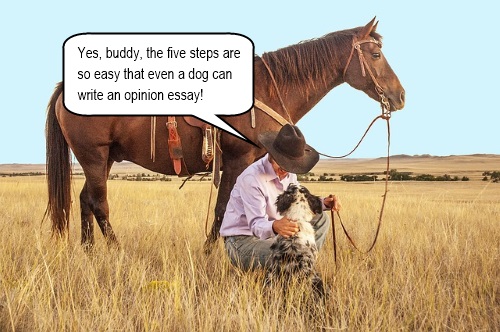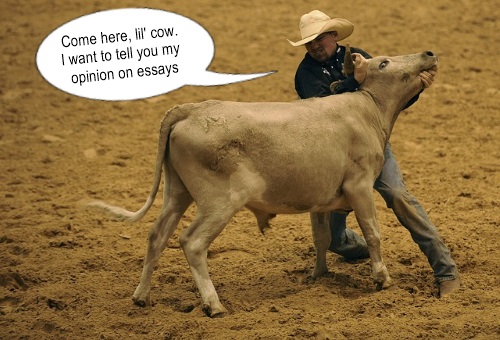You’ve just been assigned to write an opinion essay. “Opinions?!” You think, “I’ve got plenty of those!” But slow down, cowboy, you’re going to have to narrow it down to a single opinion.
More than that, you must be able to support that opinion with facts, figures, or examples from the real world.
“You are not entitled to your opinion. You are entitled to your informed opinion. No one is entitled to be ignorant.” ― Harlan Ellison
Don’t let that daunt you, though, because I’m about to guide you through how to create an opinion essay, from start to finish.
So Really, What’s an Opinion Essay?!
You want my opinion on the “opinion essay”? It’s like a 5-paragraph essay … but better!
An opinion essay is nothing more than an essay that focuses on a single opinion. You pick a point of view that you’re either in support of or against, and that’s all you focus on. Your supporting information will all contribute to that one point of view.
In contrast to an argumentative essay, a persuasive essay, or a pros and cons essay, the opinion essay focuses on one opinion. There’s no counterpoints. There’s no contrasting points of view. There’s no comparison of advantages and disadvantages.
For a few examples to get a better lay of the land when it comes to opinion essays, check out these example essays:
- An Opinion That High School Is a Boot Camp
- My Opinion on Toddlers and Tiaras
- My Opinion on Abraham Lincoln
- An Opinion of an American on America Being ‘the Most Powerful Country in the World’
Now that you know what it is, and what it isn’t, I’ll show you how to write an opinion essay in five easy steps.
Step 1: Find Your Topic
Finding a topic might be the most difficult part of writing an opinion essay because the whole essay hinges on a single point—your opinion! Find something that really interests you or that you feel strongly about.
Get your imagination going with these simple prompts:
- I believe that …
- In my opinion …
- It seems to me that …
If you’re having trouble finding the perfect topic, take a look at these 50 argumentative essay topics. Choose one that you have a strong opinion about.
Once you’ve found your topic, think of three reasons that your opinion is correct (you can have more, or fewer, but three reasons would offer good, solid support).
To do this, just start reading up on your topic, and as you read, gather the facts and figures that you will end up using as evidence. Your three reasons will develop from the trends that you see as you categorize your evidence.
Focus on the larger, thematic topic and three reasons. Let’s do an example:
Topic/thesis: Cowboys are good.
- Reason 1: Cowboys help people.
- Reason 2: Cowboys help cows.
- Reason 3: Cowboys are fun.
Stop. Don’t start writing yet. You want an outline first. Yes, you do. Trust me.
Step 2: Construct Your Outline
In college, I felt like writing an outline was writing the essay twice—double the work—until several professors forced me to start with an outline.
I discovered that an outline actually helped me through writer’s block and helped me to more quickly produce a final product.
With an outline, I already had a broken-down list of topics, a direction to go (which, by the way, kept me organized), and I had a place in my essay already picked out for all of my random thoughts.
And guess what? I got better grades because I wrote better essays. So do yourself a favor and construct an outline before you start writing your essay draft.
Here’s an example:
- Paragraph 1: Introduction
- Use a hook to engage your audience
- Introduce your topic
- 3 reasons for my opinion
- Thesis statement (my main opinion)
- Paragraph 2:
- Topic sentence includes your first reason
- Develop the first reason by giving supporting examples, facts, and statements
- Paragraph 3:
- Topic sentence includes your second reason
- Develop the second reason by giving supporting examples, facts, and statements
- Paragraph 4:
- Topic sentence includes your third reason
- Develop the third reason by giving supporting examples, facts, and statements
- Paragraph 5: Conclusion
- Restate your thesis
- Give a brief summary of your reasons
Keep reading, and gather facts to support your argument as you read. Start filling your outline in with these facts, placing them where they make the most sense.
Don’t worry yet about the intro, conclusion, or complete sentences. Just fill in the stand-alone facts, placing them where they should go.
For more help on constructing your outline, read How to Write a 5-Paragraph Essay Outline.
Step 3. Develop Your Body Paragraphs
“Writing means sharing. It’s part of the human condition to want to share things—thoughts, ideas, opinions.” ― Paulo Coelho
Once you have organized all of your facts in your outline, all you have to do is join them together with bridging language.
For example, the expanded outline for paragraph 2 might say this:
- Paragraph 2
- Topic Sentence: Cowboys help people.
- Support
- In 2007, a poll showed that 89% of the American public thought cowboys were helpful.
- In many movies, cowboys save the women and children from the bad guy. (List examples.)
- Beef comprises 27% of the meat ingested by humans. Cowboys are a necessary element of getting that beef to the table, because … (list the reasons).
- As discussed by the expert highway engineer, “Cowboys reduce traffic fatalities by keeping cows off of the roads.”
Your writing becomes much easier with the information organized. The outline just wrote your essay for you!
Now you can tie it all together into a complete paragraph:
The primary reason that cowboys are good is that cowboys help people. Each of us has that special story about the time a cowboy helped us out. The evidence, however, is more than anecdotal: a poll conducted by the Group for Cowboy Awareness in 2007 found that 89% of Americans thought that cowboys were helpful. This is overwhelming evidence that is further supported by several movies made in the same year that highlight the role of the cowboy in saving women and children from bad guys. For example, “Gone with the Mooo,” starring …
See there, all you had to do was connect the facts together. Once you have your three supporting paragraphs completed, it’s easy to use the information in those paragraphs to write your introduction and conclusion.
Step 4: Write the Introduction and Conclusion
You already have all of your facts laid out in an organized way. Your introduction will merely introduce those facts as a way of preparing your audience to read your essay, and the conclusion will bring finality to your topic.
Essentially, the introduction and conclusion wrap up your essay nice and neat.
Let’s look at the introduction and introducing your topic first. The introduction is the road map that describes the path your essay will take. Here’s what I mean by introducing.
Your outline for your introduction may look like this:
- Paragraph 1
- Hook (Think of this later.)
- Introduct topic: Cowboys are either good or bad.
- 3 reasons for my opinion
- Cowboys help people.
- Cowboys help cows.
- Cowboys are fun.
- Thesis statement (my main opinion): Cowboys are good.
- 3 reasons for my opinion
That outline then becomes a paragraph that looks something like this:
The question regarding whether cowboys are good or bad is an age-old and heavily debated question. This essay will demonstrate, first, that cowboys help people, not only by bringing food to the table, but also by keeping cows out of the way of our cars. Second, cowboys help cows. Cows have been bred into beasts that need help caring for themselves, and cows also only feel existentially fulfilled if they feel loved. Finally, cowboys are fun: nobody debates whether cowboys are fun, but the fact that they can always be relied upon for a slow-talking, folksy quote proves the point. Through the use of supporting statistics and first-person interviews of reliable experts, this essay will prove conclusively that cowboys are good.
Finally, your conclusion is nothing more than a summary. It’s brief, and it wraps up your essay’s ideas in a very broad way that allows your audience to walk away with a solid understanding of your argument.
Need help constructing yours? Read How to Write a Killer Essay Conclusion.
Step 5: Add Artistic Touches
The last thing you want to do is create the “art” of your essay. The hook element of the introduction and the very last part of your conclusion are the two things that contribute the least to your essay in terms of concrete fact.
But they contribute the most to your essay in terms of securing the interest of your audience.
This is where you get to use your creativity. Need some help with your hook? Check out this resource with five approaches: What Is a Hook Sentence? (Infographic).
Need more guidance? Tricia Grissom provides better advice than I ever could for thinking of a hook for your introduction—check out her blog post Eight Introduction Techniques that Hook Your Reader.
Step 5.5: Final Thoughts
I would be remiss if I didn’t mention the two things that remain constant in all writing:
- Cite any material that came from one of your sources. Need to follow MLA guidelines? Read How to Write MLA Citations. APA guidelines? Check out How to Write APA Citations in 4 Easy Steps).
- Edit your essay for flow, logic, grammar, and punctuation. (Need help? Kibin editors are happy to saddle up and slip on their editing boots!)
Now, by following these five easy steps, you can hopefully lasso that opinion essay without breaking a sweat.
For now, adios, amigos!







